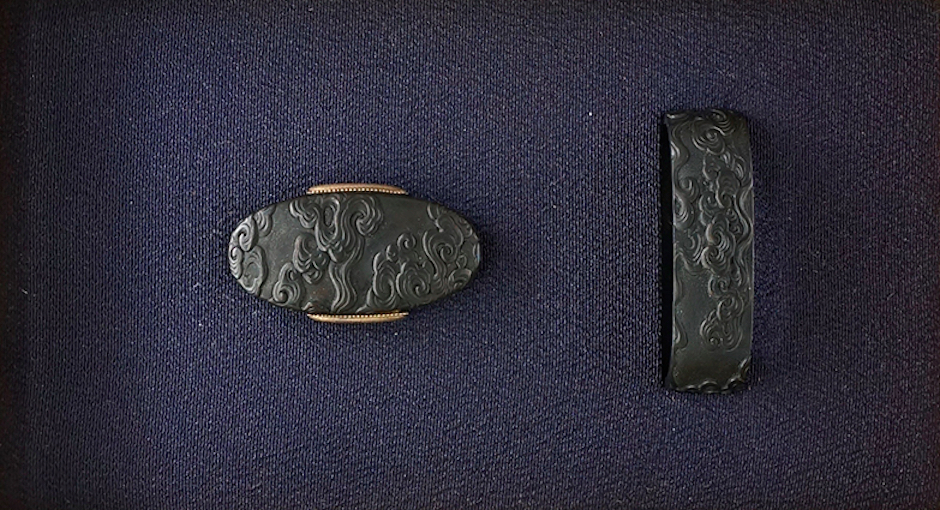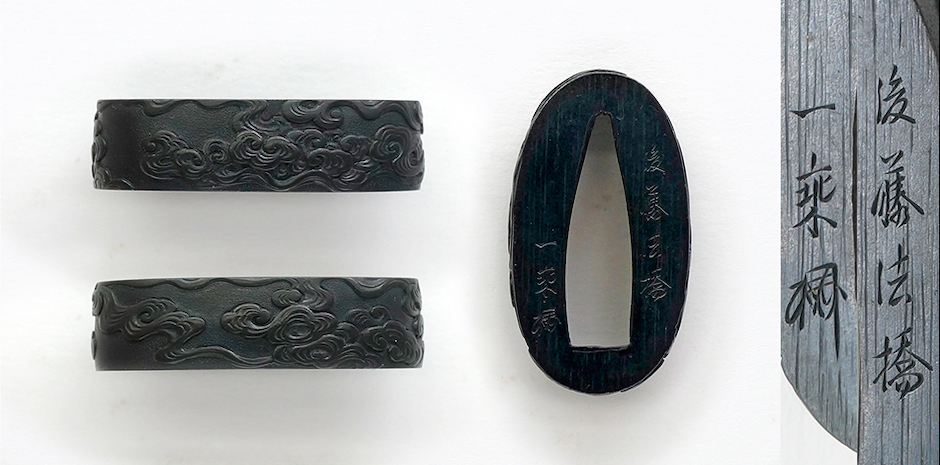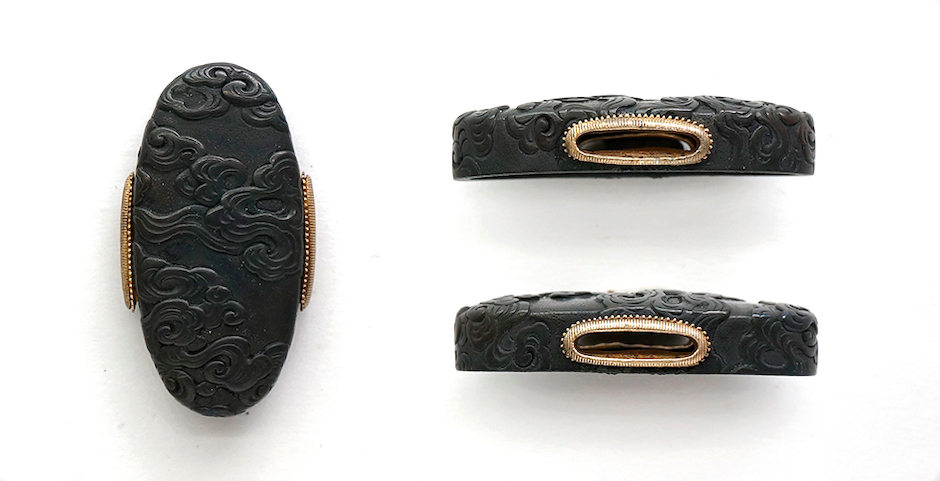Gotō-Ichijō's set of tōsōgu
The Gotō-Ichijō (後藤一乗) School
(fragment from Markus Sesko's book)
3.1 Gotō Ichijō.
Ichijō was born on the third day of the third month of Kansei three (1791) as the second son of Gotō Jūjō (重乗), the 4th generation of the Shichirō ́emon line in Kyōto. His first name in his younger years was „Eijirō“ (栄次郎) and, at the age of nine, he was adopted by Kenjō (謙乗), the 5th generation of the Hachirōbei line. But two years later he started an apprenticeship with Hanzaemon Kijō (亀乗) because of Kenjō ́s poor health. When the latter died in the fourth month of the second year of Bunka (1805), Ichijō was nominated the official successor of the Hachirōbei line. At that time he used the name „Mitsuchika" (光貸). Six years later, in Bunka eight (1811), he changed his name to „Mitsuyuki“ (光行) and worked from that time onwards for Edo ́s Shirōbei line dealing with the design of ōban coins as well as mediator between the Edo and the Kyōto branch of the Gotō family. It is unknown when he started to use the name „Mitsuyo“ (光代) but on the basis of extant signed works we can limit it to the early Bunsei era (1818~1820). On the 19th day of the twelfth month of Bunsei seven (1824) he received the rank of hokkyō (法橋) and called himself „Ichijō“. He was only 34 years old at that time.
In the twelfth month of Kaei four (1851), on orders of the bakufu, he went to Edo and was accompanied by Hashimoto Isshi (橋本一至), who had been his student for one year. Funada Ikkin (船田一琴) – another student of Ichijō – had already started his own business in Edo at that time. Extant letters of the Gotō family show that Ichijō ́s work was highly appreciated and, in the eleventh month of Ansei two (1855), he had his son Mitsunobu (光信), who had remained in Kyōto, move to Edo. Somewhat later, in the second year of Bunkyū (1862), he returned to Kyōto after spending eleven years in Edo.
He was again joined by Isshin and the reason for his return was that he had received an order from emperor Kōmei (孝明天皇, 1831-1866) for a tachi-koshirae. As a reward for this job he was promoted to the rank of hōgen (法眼) in the sixth month of Bunkyū three (1863). He was 73 years old at that time. In the second year of Keiō (1866) Mitsunobu was appointed as successor and Ichijō died on the 17th day of the tenth month of Meiji nine (1876), at the age of 86.
Regarding Ichijō ́s style, it is interesting to note that he often worked in shibuichi, with a noticeable higher silver content which makes the material look whitish [Accordingly called „shiro-shibuchi“ (白四分一, lit. „white shibuichi“) or „gin-shibuichi“ (銀四分一, lit. „silver shibuichi“)]. This alloy was not used for sword fittings before the time of Ichijō. He too was subject to the fashion of those days and therefore hardly produced any works in iebori (家彫) style – lit. „house carvings“, the general term for traditional Gotō works in shakudō with nanako ground and gold accentuations – from the Kaei (1848-1854) and Ansei (1854-1860) eras onwards.
In general, we can say that he started working in shakudō, switched toshibuchi during his prime creative period and also used iron in his later years. Ichijō succeeded in making Gotō works again „acceptable“ to high-ranking customers like the Imperial Court, the family of the Tokugawa-shōgun, and several daimyō, even though he also worked to the same extent in the then prevailing machibori style. His pupils included the most famous kinkō artists of his time like, for example, the already mentioned Funada Ikkin, Hashimoto Isshi, Nakagawa Isshō (中川一匠), Imai Nagatake (今井永武), or Araki Tōmei (荒木東明), who are described in the following chapters.
3.2 Funada Ikkin (船田一琴)
Ikkin was born in the ninth year of Bunka (1812) in Shōnai (庄内), Dewa province, as the eldest son of Funada Kanjō (寛常), who was in turn a student of Iwamoto Konkan. His youth names were Yūtarō“ (勇太郎) and later „Shōji“ (庄治). His father died when Ikkin was about eight years old. His mother later married the kinkō artist Yoshinobu (義信, 1790-1867), who was a student of Edo ́s Kumagai Shōjirō Yoshinobu (熊谷庄次郎義信). At the age of 15, Ikkin became an apprentice of his stepfather but there are several theories about his initial training. One says that his stepfather Yoshinobu was not the Kumagai Yoshinobu but a different kinkō artist with the same craftsman name but with the first name, „Sashichirō“ (佐七郎). According to the Nihontō-kōza, Ikkin had studied under Kumagai Yoshiyuki (熊谷義之), the master of Kumagai Yoshinobu. Another transmission says that Ikkin left Shōnai at 17 and entered apprenticeship with the famous master Tanaka Kiyotoshi (田中清寿, 1804-1876) in Edo.
[The Japanese toso-kinko Schools. Markus Sesko. Print & Publishing: Lulu, Inc. 2012, pp.73-75]
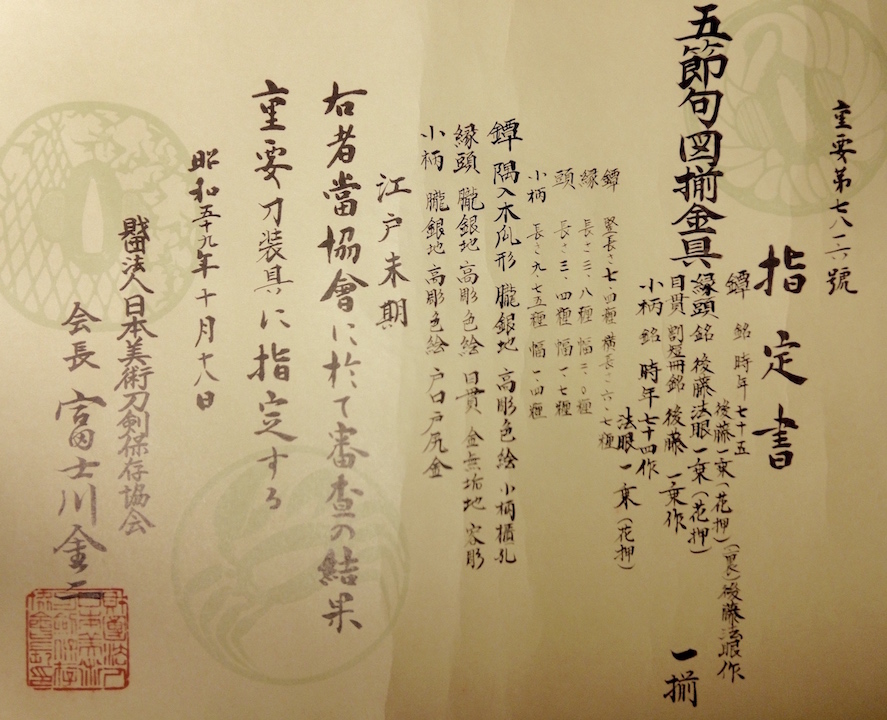
Jūyō No 7816
Certificate
gosekku no zu soroi-kanagu (五節句図揃金具) – the suite fittings depicting the Five Festivals.
Tsuba:
mei: “Jinen nanajūgo Gotō Ichijō + kaō” (時年七十五・後藤一乗, “Gotō Ichijō, aged 75”).
ura: “Gotō Hōgen saku” (後藤法眼作).
Fuchigashira:
mei: “Gotō Hōgen Ichijō + kaō” (後藤法眼一乗).
Menuki: split tanzaku-mei: “Gotō– Ichijō saku” (後藤・一乗作).
Kozuka:
mei: “Jinen nanajūyon saku – Hōgen Ichijō + kaō” (時年七十四・法眼一乗, “Hōgen Ichijō, aged 74”).
Tsuba: height 7.4 cm, width 6.7 cm.
Fuchi:length 3.8 cm, width 2.0 cm.
Kashira:length 3.4 cm, width 1.7 cm.
Kozuka:length 9.75 cm, width 1.4 cm.
Tsuba in sumiiri-mokkō-gata, of oborogin, in takabori-iroe, and with a kozuka-hitsu-ana fuchigashira of oborogin and in takabori-iroe; menuki of pure gold and in katachibori kozuka of oborogin, in takabori-iroe, and with the opening and the butt end in gold.
Late Edo Period
According to the result of the shinsa committee of our society we judged this work as authentic and rate it as jūyō-tōsōgu.
October 18th, 1984
[Juridical Foundation] Nihon Bijutsu Tōken Hozon Kyōkai, NBTHK
[President] Fujikawa Kinji (富士川金二)
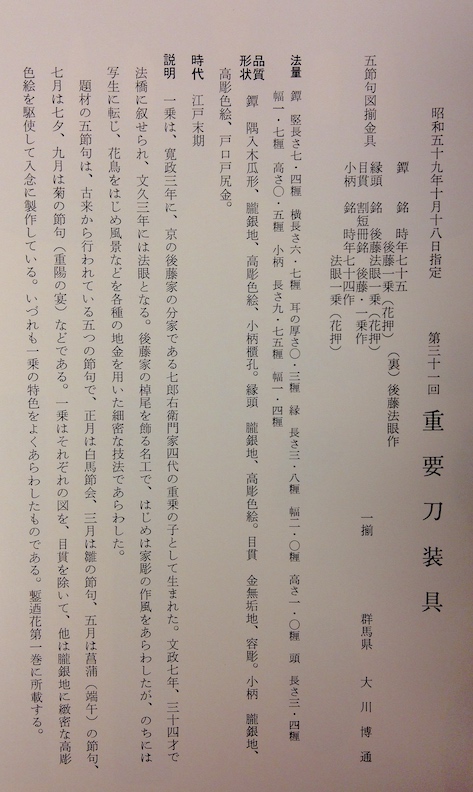
Designated as jūyō-tōsōgu at the 31st jūyō-shinsa held on October 18th 1984.
gosekku no zu soroi-kanagu (五節句図揃金具) – the suite fittings depicting the Five Festivals.
Tsuba, mei: “Jinen nanajûgo Gotō Ichijō + kaō” (時年七十五・後 藤一乗, “Gotō Ichijō, aged 75”)
ura: “Gotō Hōgen saku” (後藤法眼作).
Fuchigashira, mei: “Gotō Hōgen Ichijō + kaō” (後藤法眼一乗).
Menuki, split tanzaku-mei: “Gotō – Ichijō saku” (後藤・一乗作).
Kozuka, mei: “Jinen nanajūyon saku – Hōgen Ichijō + kaō” (時年 七十四・法眼一乗, “Hōgen Ichijō, aged 74”).
Gunma Prefecture, Ōkawa Hiromichi (大川博通)
measurements:
tsuba: height7.4 cm, width 6.7 cm, thickness at the rim 0.3 cm;
fuchi: length 3.8 cm, width 2.0 cm, height 1.0 cm;
kashira: length 3.4 cm, width 1.7 cm, height 0.5 cm;
kozuka: length 9.75 cm, width 1.4 cm.
material and interpretation: tsuba in sumiiri-mokkō-gata, of oborogin, in takabori-iroe, and with a kozuka-hitsu-ana; fuchigashira of oborogin and in takabori-iroe; menuki of pure gold and in katachibori; kozuka of oborogin, in takabori-iroe, and with the opening and the butt end in gold.
Time of production: late Edo period
Explanation:
Ichijō was born in Kansei three (1791) as son of Jūjō (重乗), the 4th generation of the Gotō Shichirṓemon (七郎右衛門) line in Kyōto. In Bunsei seven (1824), aged 34, he received the rank of hokkyō and in Bunkyū three (1863) he was promoted to the rank of hōgen. He was the last great master of the renowned Gotō family and worked initially in the iebori style of his family but changed later to more realistic interpretations. He depicted everything from birds and flowers to sceneries, used various different raw materials, and always displayed a fine and delicate workmanship.
The traditional Five Festivals, the subject of this set of fittings, started in the first month with the White Horse seasonal court banquet (aouma no sechi-e, 白馬節), followed in the third month by the Doll's Day (hina no sekku, 雛の節句), in the fifth month by the Water Lily or Boy's Day (ayame no sekku, 菖蒲の節句 or respectively tango no sekku, 端午の節句), in the seventh month by the Star Festival (tanabata, 七夕), and was concluded in the ninth month by the Chrysanthemum Day (kiku no sekku, 菊の節句or also referred to as chōyōno en, 重陽の宴). Except for the menuki, Ichijō worked all the individual traditional festivals out of oborogin. The takabori carvings are delicate and he made much use of iroe, all of course in an elaborate manner, and so this set shows very well the characteristic features of Ichijō. The set is also depicted in volume 1 of the book Tagane no Hana.
The kiri box made by Ryūshidō (龍獅堂), hakogaki made by Ikeda Takao (池田隆雄). Ikeda Takao was one of the most famous disciple of Kanō Natsuo (加納夏雄, 1828-1898).
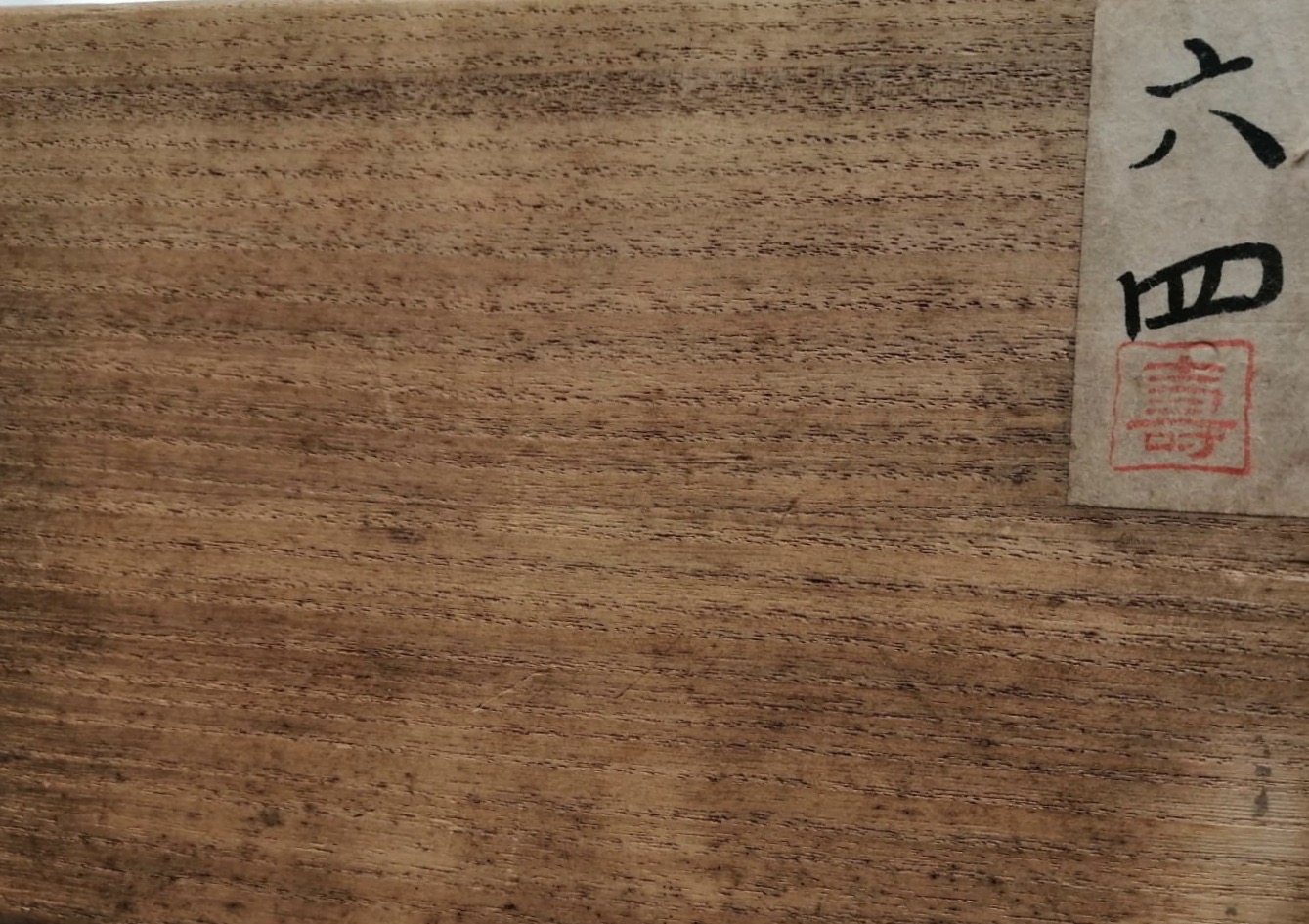
The outer wood box made by Ryūshidō.
Provenance: formerly owned by Ryūhidō (Mitsumura Toshimo) and published in his book Tagane no Hana.
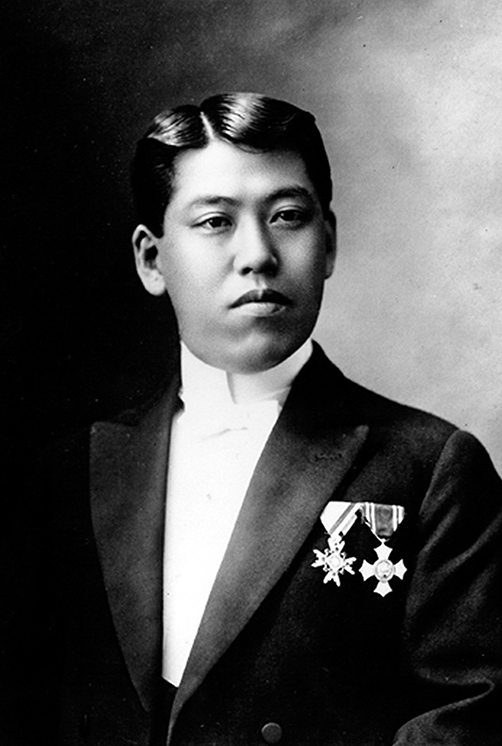
Mitsumura Toshimo (光村利藻, 1877-1955), also known as Ryūshidō (龍獅堂), was a major sword and sword fittings collector of the Meiji era. For not letting the sword and sword fittings related crafts become extinct with the changes of the Meiji Restoration, Ryūshidō did not only collect but commissioned contemporary artists to make for example new koshirae and the like. He was born on November 4th 1877 as oldest son of Mitsumura Yahei (光村弥兵衛), a wealthy industrialist from Yamaguchi Prefecture involved in railway and shipping industries in the Kansai area. He was very interested in photography and founded in 1901 the “Kansai Photo Plate Making Company”, a printing company based in Kōbe. In 1918, Mitsumura moved his entire base of operations to Tōkyō and changed the name of his company to the “Mitsumura Printing Company” in 1928 and retired six years later. His work was aiming at art printing and his so-called “Mitsumura tricolor printing” was widely recognized and admired. Mitsumura passed away on February 21st 1955, aged 77. He was born and grew up in Ōsaka.
Publications: Tagane no Hana by Mitsumura Toshimo, 1971, Vol. 1, p.
Dai Token Ichi catalog 2014, p.
Tagane no Hana
soroi-kanagu (揃金具) Kōbe, Mr. Ryūshidō (龍獅堂)
1 tsuba: gosekku no zu (五節句ノ圖)
mei: Jinen nanajūgo – Gotō Hōgen saku – Ichijō + kaō
foundation: oborogin
carvings: takabori, gold and silver iroe
1 back side
1 fuchigashira: gosekku no zu (五節句ノ圖)
mei: Gotō Hōgen Ichijō + kaō
foundation: oborogin
carvings: takabori, gold and silver iroe
1 kozuka: gosekku no zu (五節句ノ圖)
mei: Jinen nanajūyon – Hōgen Ichijō + kaō
foundation: oborogin
carvings: takabori, tsukagashira in gold, gold, silver and copper iroe-zōgan
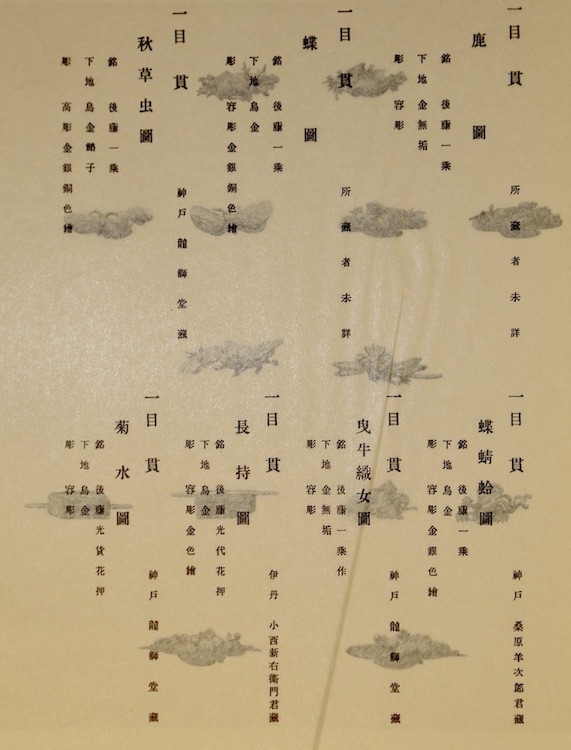
1 menuki Kōbe, Mr. Ryūshidō (龍獅堂)
Hikoboshi Orihime no zu (曳牛織女圖) – Hikoboshi and Orihime [representatives of tanabata]
mei: Gotō Ichijō saku
foundation: pure gold
carvings: katachibori
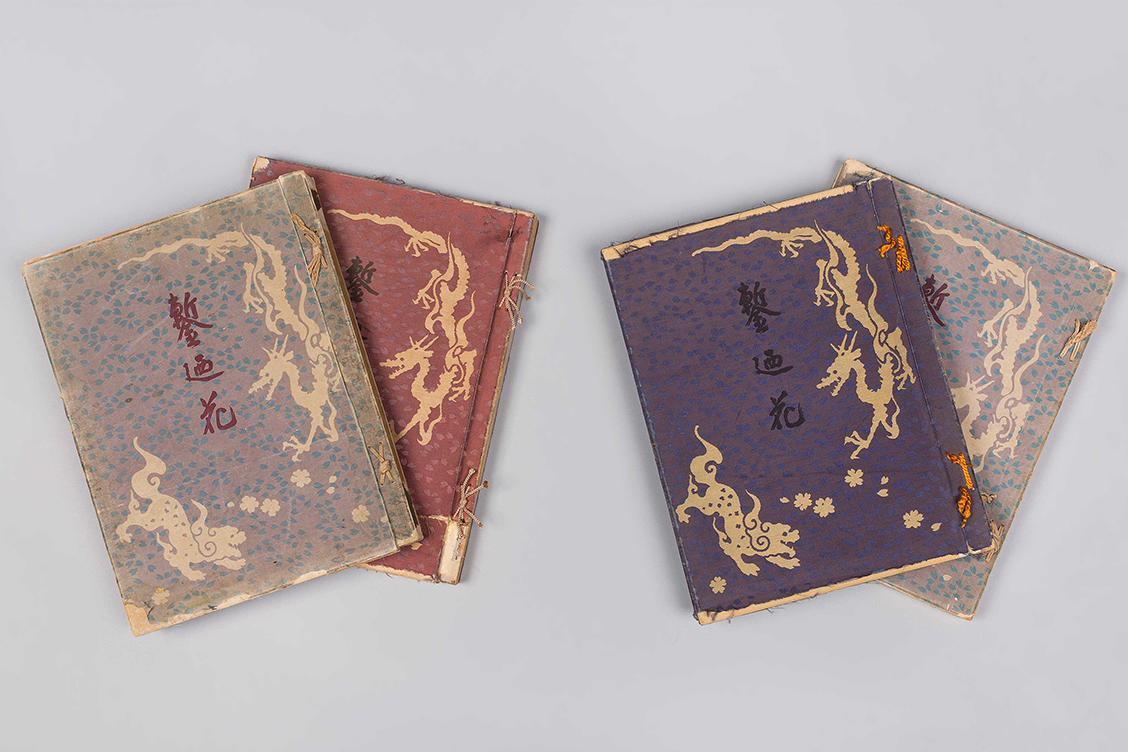
The original four volume 1st edition of the Tagane no Hana was printed in 1901.
Dai Token Ichi Catalog 2014
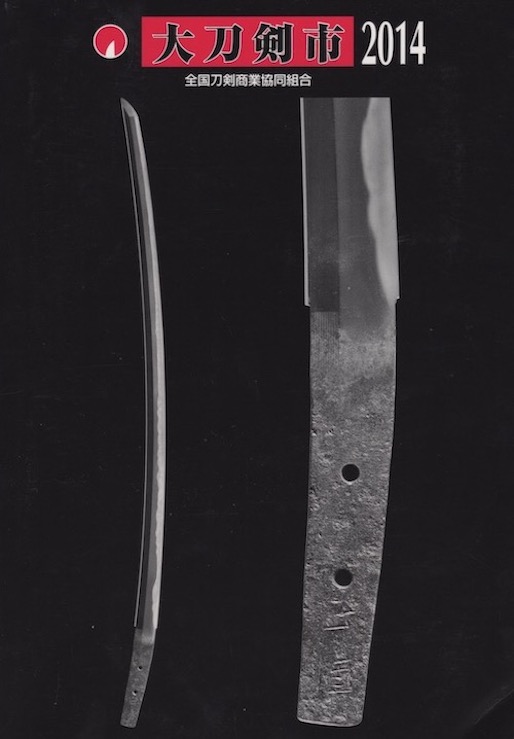
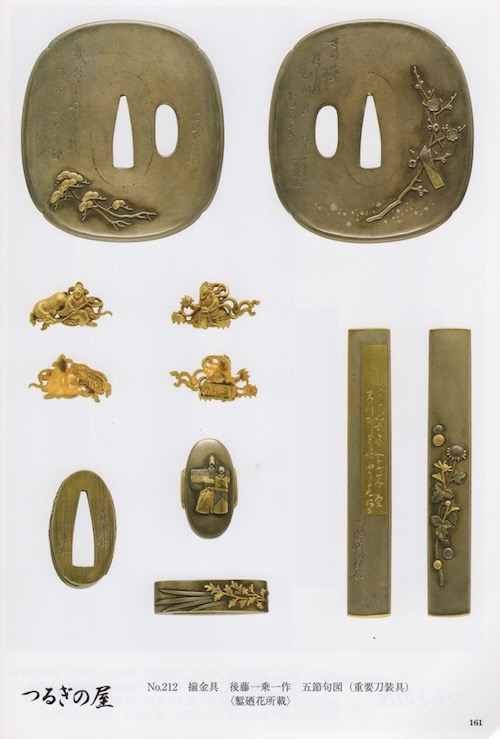
Fuchi Kashira : NBTHK Tokubetsu Hozon Paper
Mei (signature) : Gotō Hokkyō Ichijō (後藤法橋一乗). (Kaō)
Fuchi Length : 3.95 cm x 2.23 cm x 1.05 cm
Kashira Length : 3.47 cm x 1.64 cm x 0.78 cm
Special feature : On the shakudo ishime-ji (石目地) plate, clouds are engraved with top quality engraving.
